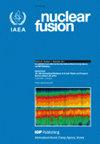使用国际热核聚变实验堆级分流器进行 WEST 全钨操作
IF 3.5
1区 物理与天体物理
Q1 PHYSICS, FLUIDS & PLASMAS
引用次数: 0
摘要
WEST(稳态托卡马克中的钨-W环境)的任务是探索全钨(W)环境下的长脉冲运行,为下一步聚变装置(ITER和DEMO)做准备,重点是在托卡马克条件下测试ITER主动冷却W分流器。在成功完成第 1 阶段(2016-2021 年)之后,第 2 阶段于 2022 年 12 月开始,下部岔流器完全由主动冷却的热核实验堆级钨单块制成。在首次等离子体尝试之前进行的硼化使新的岔流器得以顺利启动。尽管由于使用钨而减少了运行窗口,但在长脉冲运行方面取得了快速进展,产生了脉冲长度为 100 秒的放电,每次放电注入的能量约为 300 兆焦耳。利用赤道氮化硼限幅器进行了等离子体启动研究,以便与钨限幅器进行比较,同时还尝试了 ICRH 辅助启动。等离子体通量的增加会影响等离子体的运行,而等离子体通量的增加也会影响等离子体的运行。在第一批活动中,累计注入能量达到 43 GJ,累计等离子体时间超过 5 小时。还报告了受控 X 点辐射器制度的演示,为研究等离子体排气和等离子体与壁的相互作用问题开辟了一条前景广阔的道路。本文总结了从热核实验堆级分流器的制造和首次运行中吸取的经验教训,介绍了在全 W 环境下优化运行方面取得的进展,重点是长脉冲运行和等离子体壁相互作用。本文章由计算机程序翻译,如有差异,请以英文原文为准。
WEST full tungsten operation with an ITER grade divertor
The mission of WEST (tungsten-W Environment in Steady-state Tokamak) is to explore long pulse operation in a full tungsten (W) environment for preparing next-step fusion devices (ITER and DEMO) with a focus on testing the ITER actively cooled W divertor in tokamak conditions. Following the successful completion of phase 1 (2016-2021), phase 2 started in December 2022 with the lower divertor made entirely of actively cooled ITER-grade tungsten mono-blocks. A boronization prior the first plasma attempt allowed for a smooth startup with the new divertor. Despite the reduced operating window due to tungsten, rapid progress has been made in long pulse operation, resulting in discharges with a pulse length of 100 s and an injected energy of around 300 MJ per discharge. Plasma startup studies were carried out with equatorial boron nitride limiters to compare them with tungsten limiters, while ICRH assisted startup was attempted. High fluence operation in attached regime, which was the main thrust of the first campaigns, already showed the progressive build up of deposits and appearance of dust, impacting the plasma operation as the plasma fluence increased. In total, the cumulated injected energy during the first campaigns reached 43 GJ and the cumulated plasma time exceeded 5 hours. Demonstration of controlled X-Point Radiator regime is also reported, opening a promising route for investigating plasma exhaust and plasma-wall interaction issues in more detached regime. This paper summarises the lessons learned from the manufacturing and the first operation of the ITER-grade divertor, describing the progress achieved in optimising operation in a full W environment with a focus on long pulse operation and plasma wall interaction.
求助全文
通过发布文献求助,成功后即可免费获取论文全文。
去求助
来源期刊

Nuclear Fusion
物理-物理:核物理
CiteScore
6.30
自引率
39.40%
发文量
411
审稿时长
2.6 months
期刊介绍:
Nuclear Fusion publishes articles making significant advances to the field of controlled thermonuclear fusion. The journal scope includes:
-the production, heating and confinement of high temperature plasmas;
-the physical properties of such plasmas;
-the experimental or theoretical methods of exploring or explaining them;
-fusion reactor physics;
-reactor concepts; and
-fusion technologies.
The journal has a dedicated Associate Editor for inertial confinement fusion.
 求助内容:
求助内容: 应助结果提醒方式:
应助结果提醒方式:


